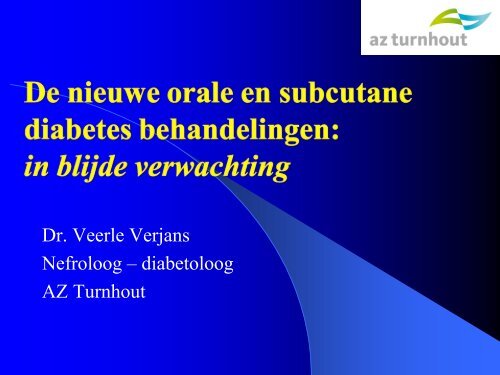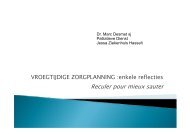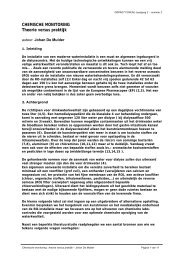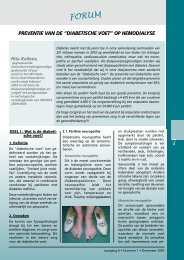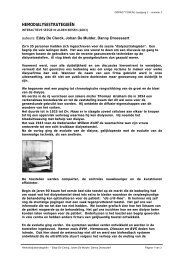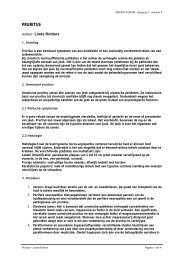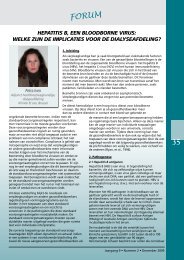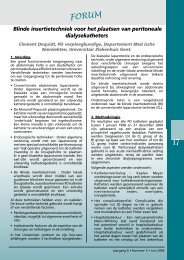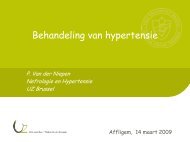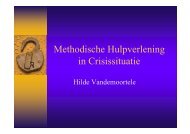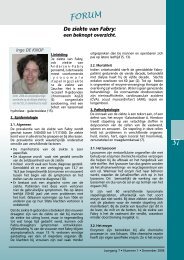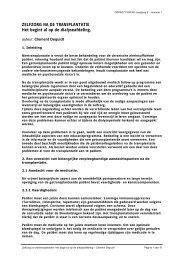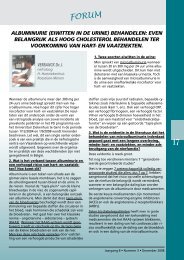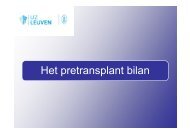Dr. Veerle Verjans Nefroloog - Orpadt
Dr. Veerle Verjans Nefroloog - Orpadt
Dr. Veerle Verjans Nefroloog - Orpadt
Create successful ePaper yourself
Turn your PDF publications into a flip-book with our unique Google optimized e-Paper software.
<strong>Dr</strong>. <strong>Veerle</strong> <strong>Verjans</strong><br />
<strong>Nefroloog</strong> – diabetoloog<br />
AZ Turnhout
<strong>Dr</strong>. <strong>Veerle</strong> <strong>Verjans</strong><br />
<strong>Nefroloog</strong> – diabetoloog<br />
AZ Turnhout
<strong>Dr</strong>. <strong>Veerle</strong> <strong>Verjans</strong><br />
<strong>Nefroloog</strong> – diabetoloog<br />
AZ Turnhout
AANDACHT-AANDACHT<br />
AANDACHT AANDACHT
1.Overzicht DM type 2<br />
2.Incretines: pathofysiologie<br />
3.Incretines: exenatide/ liraglutide/ DPP4inhibitoren<br />
4.ADA-richtlijnen
WHO: toename van prevalentie van type 2 DM en<br />
obesitas<br />
Diabetes1 Weight2 Individuals (Millions)<br />
WHO = World Health Organization<br />
1. WHO. Diabetes. Available at: http://www.who.int/mediacentre/factsheets/fs312/en/. Accessed March 2009.<br />
2. WHO. Obesity and overweight. Available at: http://www.who.int/mediacentre/factsheets/fs311/en/index.html. Accessed March 2009.<br />
Individuals (Billions)
Type 2 DM: gezondheidsprobleem<br />
* Meest frekwente oorzaak blindheid bij volw.<br />
* Frekwente oorzaak nierfalen (> 1/3 v.d.<br />
dialysepatiënten)<br />
* 2-4x hogere mortaliteit bij ischem hartfalen<br />
* 2-6x meer CVA<br />
* 4x meer perifeer vasculair lijden<br />
* 15x meer amputaties (> 65y x25)<br />
* 7-15% van volksgezondheidsbudget
UKPDS: HbA1c – 1 %<br />
DM type 2<br />
Microvascular<br />
complications<br />
Retinopathy, neuropathy,<br />
nephropathy<br />
-37%<br />
Myocardial<br />
infarction<br />
Fatal and nonfatal MI<br />
Deaths related<br />
to diabetes<br />
-14% -21%<br />
Daling van Hba1c vermindert aantal diabetescomplicaties<br />
UK Prospective Diabetes Study (UKPDS) Group. Lancet. 1998;352:837-853.
Pathofysiologie DM type2<br />
Liver<br />
Excess<br />
glucagon<br />
Diminished<br />
insulin<br />
Insulin deficiency<br />
Pancreas<br />
Hyperglycemia<br />
Alpha cell<br />
produces<br />
excess<br />
glucagon<br />
Islet<br />
Muscle and fat<br />
Excess glucose output Insulin resistance<br />
Adapted from Buse JB et al. In Williams Textbook of Endocrinology. 10th ed. Philadelphia, Saunders, 2003:1427–1483; Buchanan TA Clin<br />
Ther 2003;25(suppl B):B32–B46; Powers AC. In: Harrison’s Principles of Internal Medicine. 16th ed. New York: McGraw-Hill, 2005:2152–2180;<br />
Rhodes CJ Science 2005;307:380–384.<br />
Diminished<br />
insulin<br />
Beta cell<br />
produces<br />
less insulin
Perorale medicatie Type 2 DM<br />
Sulphonylurea<br />
Repaglinide<br />
Stimuleren pancreas<br />
Metformine<br />
Verminderen<br />
hepatische glucose<br />
output<br />
-<br />
+<br />
Carbohydrate<br />
DIGESTIVE ENZYMES<br />
Glucose<br />
Insulin<br />
(I)<br />
Glucose (G)<br />
G<br />
I<br />
G<br />
I<br />
I<br />
G<br />
I<br />
G<br />
G<br />
I<br />
G<br />
I<br />
G<br />
I<br />
G<br />
I<br />
G<br />
G<br />
I<br />
G<br />
-<br />
-<br />
+<br />
Thiazolidinediones<br />
Verminderen insuline resistentie
klasse generische naam producten<br />
biguaniden metformine Glucophage ® , Metformax ® ,<br />
Merck-metformine<br />
Merck metformine ®<br />
gliniden repaglinide NovoNorm ®<br />
sulphonylurea gliclazide (Uni Uni)Diamicron )Diamicron ® , Merck- Merck<br />
Gliclazide ®<br />
glipizide Glibenese ® , Minidiab ®<br />
gliquidone Glurenorm ®<br />
glibenclamide Bevoren ® , Daonil ® , Euglucon ®<br />
gliclazide L.A. L.A Uni diamicron ®<br />
glimepiride Amarylle ®<br />
glitazones pioglitazone Actos ®<br />
glucosidase<br />
remmers<br />
Combinatie<br />
met meformine<br />
rosiglitazone Avandia ®<br />
acarbose Glucobay ®<br />
+ glibenclamide<br />
+ rosiglitazone<br />
Glucovance ®<br />
Avandamet ®<br />
Glucovance<br />
Avandamet
Glitazonen<br />
* Vochtretentie, CAVE hartfalen<br />
* Fracturen ( rosiglitazone )<br />
* Myocardinfarct: rosiglitazone vs pioglitazone
AANDACHT-AANDACHT<br />
AANDACHT AANDACHT<br />
1. Metformines stop zo klaring < 30 ml/min<br />
lactaatacidose<br />
1. Sulfonylurea’s: enkel gliquidon (glurenorm)<br />
zo klaring < 30 ml/min<br />
langdurige hypoglycemie
Type 2 DM: outcome<br />
43% van de patiënten behalen de targets niet<br />
(HbA 1c
R/ type 2 DM en gewichtstoename<br />
Change in weight (kg)<br />
UKPDS: up to 8 kg in 12 years<br />
8<br />
7<br />
6<br />
5<br />
4<br />
3<br />
2<br />
1<br />
0<br />
Insulin (n=409)<br />
Glibenclamide (n=277)<br />
Metformin (n=342)<br />
0 3 6 9 12<br />
Years from randomisation<br />
Conventional treatment (n=411);<br />
diet initially then sulphonylureas, insulin and/or<br />
metformin if FPG >15 mmol/L<br />
Weight (kg)<br />
100<br />
ADOPT: up to 4.8 kg in 5 years<br />
96<br />
92<br />
88<br />
0<br />
0 1<br />
Rosiglitazone<br />
Metformin<br />
Glibenclamide<br />
UKPDS 34. Lancet 1998:352:854–65. n=at baseline; Kahn et al. (ADOPT). NEJM 2006;355:2427–43<br />
2 3 4<br />
Years<br />
5
Hba1c < 7% blijft niet<br />
Median HbA 1c (%)<br />
UKPDS<br />
9<br />
8.5<br />
8<br />
7.5<br />
7<br />
6.5<br />
6<br />
0<br />
Conventional*<br />
Glibenclamide<br />
Metformin<br />
Insulin<br />
Recommended<br />
treatment<br />
target 15 mmol/L; †ADA clinical practice recommendations. UKPDS<br />
34, n=1704<br />
UKPDS 34. Lancet 1998:352:854–65; Kahn et al. (ADOPT). NEJM 2006;355:2427–43<br />
8<br />
7.5<br />
7<br />
6.5<br />
6<br />
ADOPT<br />
0 1 2 3 4 5<br />
Time (years)<br />
Rosiglitazone<br />
Metformin<br />
Glibenclamide
Diabetes type 2, een ziekte met een<br />
stille evolutie<br />
progressieve vermindering van<br />
insulinesecretie<br />
Functie van<br />
de ß-cellen (%)<br />
100<br />
75<br />
50<br />
25<br />
0<br />
jaren sinds de diagnose<br />
Lebovitz Diabetes Reviews 1999; 7: 139-153<br />
Glucose intolerantie<br />
Verhoogde postprandiale glycemie<br />
Verhoogde nuchtere glycemie<br />
-12 -10 -6 -2 0 2 6 10 14
1.Overzicht DM type 2<br />
2.Incretines: pathofysiologie
GLP = glucagon like peptide ( jejunum - colon )<br />
GIP = glucose dependent insulinotropic peptide ( duodenum )
Fysiologie van Incretines<br />
Ingestion of<br />
food<br />
GI tract<br />
Release of<br />
incretin gut<br />
hormones<br />
Active<br />
GLP-1 and GIP<br />
Pancreas<br />
Beta cells<br />
Alpha cells<br />
Glucose dependent<br />
Insulin<br />
from beta cells<br />
(GLP-1 and GIP)<br />
Glucagon<br />
from alpha cells (GLP-<br />
1)<br />
Glucose dependent<br />
Insulin<br />
increases<br />
peripheral<br />
glucose<br />
uptake<br />
Increased insulin and<br />
decreased<br />
glucagon<br />
reduce<br />
hepatic<br />
glucose output<br />
Blood<br />
glucose control<br />
Adapted from Brubaker PL, <strong>Dr</strong>ucker DJ Endocrinology 2004;145:2653–2659; Zander M et al Lancet 2002;359:824–830; Ahrén B Curr Diab Rep 2003;3:365– 20<br />
372; Buse JB et al. In Williams Textbook of Endocrinology. 10th ed. Philadelphia, Saunders, 2003:1427–1483.
Fysiologie van incretines<br />
Beta-cellen en alfacellen<br />
van de pancreas<br />
Hersenen:<br />
Stimuleert verzadiging en<br />
vermindert voedselinname<br />
Lever<br />
Maag :<br />
Vertraagt de maaglediging
Plasmaglycemie aders (mmol/l)<br />
Het “incretine incretine-effect effect”<br />
11<br />
5.5<br />
0<br />
Tijd (min)<br />
Peptide-c (nmol/L)<br />
0 1 60 120 180 0 1 60 120 180<br />
0 2<br />
Studie in cross over bij niet-diabetici (n=6)<br />
Gemiddelden ± SE; *p ≤.0,05; 0 1 -0 2 = Perfusietijd van glucose.<br />
(1) Nauck MA, et al.. J Clin Endocrinol Metab. 1986;63:492-498.<br />
Orale glucose<br />
IV glucose<br />
2.0<br />
1.5<br />
1.0<br />
0.5<br />
0.0<br />
0 2<br />
*<br />
*<br />
*<br />
Tijd (min)<br />
*<br />
*<br />
Incretine-<br />
*<br />
effect<br />
*
Incretine-effect Incretine effect is<br />
verminderd bij DM type 2<br />
Glucose<br />
(mg/100 ml)<br />
Insulin<br />
(µU/ml)<br />
Glucagon<br />
(µµg/ml)<br />
360<br />
330<br />
300<br />
270<br />
240<br />
110<br />
80<br />
150<br />
120<br />
90<br />
60<br />
30<br />
0<br />
140<br />
130<br />
120<br />
110<br />
100<br />
90<br />
Type 2 diabetes mellitus (n=12)*<br />
Nondiabetic controls (n=11)<br />
–60<br />
Meal<br />
*Insulin measured in five patients<br />
23<br />
Adapted from Müller WA et al N Engl J Med 1970;283:109–115.<br />
Nonsuppressed glucagon<br />
0 60 120 180 240<br />
Time (minutes)<br />
Depressed/delayed insulin response
Incretin-effect Incretin effect is<br />
verminderd bij DM type 2<br />
GLP-1 (pmol/L)<br />
20<br />
15<br />
10<br />
5<br />
0<br />
*p
Incretine-effect Incretine effect is<br />
verminderd bij DM type 2<br />
Insulin (nmol liter –1 min)<br />
60<br />
50<br />
40<br />
30<br />
20<br />
10<br />
0<br />
7.4<br />
*Low rate=0.4 pmol kg –1 min –1<br />
**High rate=1.2 pmol kg –1 min –1<br />
***vs. corresponding NGT group<br />
NGT (n=9)<br />
Type 2 diabetes (n=9)<br />
Study included four examinations per patient: 1) an oral glucose challenge; and hyperglycemic clamp experiments with<br />
administration of 2) glucagon; 3) GIP; and 4) GLP-1. Only results for GLP-1 are shown.<br />
Adapted from Nauck MA et al J Clin Invest 1993;91:301–307.<br />
51.4<br />
GLP-1 infusion (low rate)*<br />
GLP-1 infusion (high rate)**<br />
P=NS***<br />
7.5<br />
P=NS***<br />
38.2<br />
Normale GLP-1 werking
GLP-1 GLP 1 infusie bij DM type 2<br />
Glucose<br />
(mmol/L)<br />
Insulin<br />
(pmol/L)<br />
Glucagon<br />
(pmol/L)<br />
15.0<br />
12.5<br />
10.0<br />
7.5<br />
5.0<br />
250<br />
200<br />
150<br />
100<br />
50<br />
20<br />
15<br />
10<br />
5<br />
N=10 patients with type 2 diabetes. Patients were studied on two occasions. A regular meal and drug schedule was allowed for<br />
one day between the experiments with GLP-1 and placebo.<br />
*p
GLP-1 GLP 1 infusie bij DM type 2<br />
Snelle inactivatie (DPP-4),<br />
Korte halveringstijd (~1-2 min)<br />
GLP-1 moet onophoudelijk worden toegediend<br />
(perfusie)<br />
Niet geschikt voor de behandeling<br />
van een chronische ziekte zoals diabetes type 2<br />
Nabootsen van effecten van GLP-1 : Incretine mimetica<br />
Verlengen van het half-leven van GLP-1 na de maaltijden: DPP-4 inhibitoren
Medicaties voor Type 2 DM<br />
Sulphonylurea<br />
Repaglinide<br />
Stimuleren pancreas<br />
Metformine<br />
Verminderen<br />
hepatische glucose<br />
output<br />
-<br />
+<br />
Carbohydrate<br />
DIGESTIVE ENZYMES<br />
Glucose<br />
Insulin<br />
(I)<br />
Insulines<br />
Glucose (G)<br />
G<br />
I<br />
Incretines (DPP-4, GLP-1<br />
Effect op beta- (insuline)<br />
en alfacel (glucagon)<br />
G<br />
I<br />
I<br />
G<br />
I<br />
G<br />
G<br />
I<br />
G<br />
I<br />
G<br />
I<br />
G<br />
I<br />
G<br />
G<br />
I<br />
G<br />
-<br />
-<br />
+<br />
Thiazolidinediones<br />
Verminderen insuline resistentie
Incretines<br />
DPP-4 inhibitoren: (oraal, incretine enhancers)<br />
– Januvia (Sitagliptine)<br />
– Galvus (Vildagliptine)<br />
– Saxaglipitine<br />
Incretinemimetica: (SC, GLP-1 analogen)<br />
– Byetta (Exenatide) 5 -10 µg 2 x per dag SC<br />
– Victoza (Liraglutide) 1 x SC per dag (? Begin 2010)<br />
– Exanatide QW 1 X SC per week (? 2011)
1.Overzicht DM type 2<br />
2.Incretines: pathofysiologie<br />
3.Incretines: exenatide
Exenatide (BYETTA)<br />
Synthetische versie van een<br />
proteïne dat wordt gevonden in<br />
het speeksel van een hagedis<br />
(Gila monster)<br />
Ongeveer 50% overeenkomst<br />
met het humane GLP-1<br />
Heeft een gelijkaardige<br />
bindingsaffiniteit met de GLP-1<br />
receptoren van de β-cellen<br />
Resistent aan de inactivatie door<br />
DPP-4<br />
Adapted from Nielsen LL, et al. Regulatory Peptides. 2004;117:77-88.; Fineman MS, et al. Diabetes Care. 2003;26:2370-2377.<br />
Reproduced from Regulatory Peptides, 117, Nielsen LL, et al, Pharmacology of exenatide (synthetic exendin-4): a potential therapeutic for improved<br />
glycemic control of type 2 diabetes, 77-88, 2004, with the permission of Elsevier.
Exenatide Effects on Diabetes, Obesity,<br />
Cardiovascular Risk Factors, and Hepatic<br />
Biomarkers in Patients with Type 2 Diabetes<br />
Treated for at least 3 years<br />
David C. Klonoff, MD, FACP 1 ; John B. Buse, MD, PhD 2 ; Loretta L. Nielsen, PhD 3 ;<br />
Xuesong Guan, MS 3 ; Christopher L. Bowlus, MD 4 ; John H. Holcombe, MD 5 ;<br />
Matthew E. Wintle, MD 3 ; David G. Maggs, MD 3 .<br />
1 Diabetes Res Inst., Mills-Peninsula Hlth. Services, San Mateo, CA; 2 Division of<br />
Endocrinology, Dept. of Medicine, Univ. North Carolina School Med., Chapel Hill,<br />
NC; 3 Amylin Pharmaceuticals, Inc., San Diego, CA; 4 Univ. California-Davis, Davis,<br />
CA; 5 Eli Lilly and Co., Indianapolis, IN.
Exenatide:<br />
Exenatide:<br />
verlaging Hba1c<br />
% ∆ HbA 1c<br />
0.0<br />
-1.0<br />
-2.0<br />
-3.0<br />
HbA1c < 9% HbA1c ≥ 9%<br />
-0.6%<br />
-2.1%<br />
Klonoff DC, et al. Curr Med Res Opin 2008;24:275-286.<br />
♦ - 0.6% decrease with baseline<br />
HbA1c < 9% (mean 7.8%)<br />
♦ - 2.1% decrease with baseline<br />
HbA1c ≥ 9% (mean 9.7%)
Exenatide:<br />
Exenatide:<br />
verlaging Hba1c<br />
Hba1c blijft laag !!!<br />
1c (%)<br />
HbA<br />
10<br />
9<br />
Baseline 8.2 ± 0.1%<br />
Week 156<br />
-1.0% (95% CI:-1.1 to -0.8%)<br />
8<br />
7<br />
6<br />
5<br />
4<br />
0 26 52 78 104 130 156<br />
Duur (weken)<br />
Klonoff DC, et al. Curr Med Res Opin 2008;24:275-286.
Hba1c < 7% blijft niet<br />
Median HbA 1c (%)<br />
UKPDS<br />
9<br />
8.5<br />
8<br />
7.5<br />
7<br />
6.5<br />
6<br />
0<br />
Conventional*<br />
Glibenclamide<br />
Metformin<br />
Insulin<br />
Recommended<br />
treatment<br />
target 15 mmol/L; †ADA clinical practice recommendations. UKPDS<br />
34, n=1704<br />
UKPDS 34. Lancet 1998:352:854–65; Kahn et al. (ADOPT). NEJM 2006;355:2427–43<br />
8<br />
7.5<br />
7<br />
6.5<br />
6<br />
ADOPT<br />
0 1 2 3 4 5<br />
Time (years)<br />
Rosiglitazone<br />
Metformin<br />
Glibenclamide
Exenatide:<br />
Exenatide:<br />
verlaging Hba1c<br />
en gewicht<br />
Gewichtsverandering sinds Baseline (kg)<br />
0<br />
-2<br />
-4<br />
Baseline 99.3 ± 1.2 kg<br />
-6<br />
0 26 52 78 104 130 156<br />
N=217 Mean±SE<br />
Week 156<br />
-5.3 kg (95% CI: -6.0 to -4.5 kg)<br />
Duur (weken)<br />
1c (%)<br />
HbA<br />
10<br />
9<br />
Baseline 8.2 ± 0.1%<br />
Week 156<br />
-1.0% (95% CI:-1.1 to -0.8%)<br />
8<br />
7<br />
6<br />
5<br />
4<br />
0 26 52 78 104 130 156<br />
Duur (weken)<br />
Klonoff DC, et al. Curr Med Res Opin 2008;24:275-286.
R/ type 2 DM en<br />
gewichtstoename<br />
Change in weight (kg)<br />
UKPDS: up to 8 kg in 12 years<br />
8<br />
7<br />
6<br />
5<br />
4<br />
3<br />
2<br />
1<br />
0<br />
Insulin (n=409)<br />
Glibenclamide (n=277)<br />
Metformin (n=342)<br />
0 3 6 9 12<br />
Years from randomisation<br />
Conventional treatment (n=411);<br />
diet initially then sulphonylureas, insulin and/or<br />
metformin if FPG >15 mmol/L<br />
Weight (kg)<br />
100<br />
ADOPT: up to 4.8 kg in 5 years<br />
96<br />
92<br />
88<br />
0<br />
0 1<br />
Rosiglitazone<br />
Metformin<br />
Glibenclamide<br />
UKPDS 34. Lancet 1998:352:854–65. n=at baseline; Kahn et al. (ADOPT). NEJM 2006;355:2427–43<br />
2 3 4<br />
Years<br />
5
Hoera: vermagering !!!
Exenatide vs Insuline<br />
BYETTA: glycemische controle vergelijkbaar met insuline glargine<br />
% ∆ HbA 1c<br />
Verandering HbA1C (%) na 26W<br />
0.0<br />
-0.5<br />
-1.0<br />
-1.5<br />
-1.1% -1.1%<br />
Bevolking Per Protocol<br />
BYETTA 10µg 2/d (n=228)<br />
Insuline glargine (n=227)<br />
Heine RJ, et al. Ann Intern Med. 2005;143:559-569.<br />
% Patiënten die een<br />
HbA1c ≤ 7% halen<br />
60<br />
50<br />
40<br />
30<br />
20<br />
10<br />
0<br />
Bevolking ITT<br />
BYETTA 10µg 2/d (n=275)<br />
Insuline glargine (n=260)<br />
46% 48%<br />
% Patiënten die een<br />
HbA 1c ≤ 7% halen op 26 weken
Exenatide vs insuline<br />
Progressief gewichtsverlies vs. insuline<br />
∆ gewicht (kg)<br />
Gewichtsschommeling (kg) na 26 weken<br />
3<br />
2<br />
1<br />
0<br />
-1<br />
-2<br />
-3<br />
* *<br />
0 2 4 8 12 18 26<br />
ITT-bevolking; Het gewicht bij de opname was ( gemiddeld ± ET) : exenatide 87,5 ± 16,9 kg<br />
en insulineglargine 88,3 ± 17,9 kg; Gemiddeld ± SE; *p
Exenatide verbetert<br />
lipidenprofiel<br />
Mean Change (%)<br />
30<br />
25<br />
20<br />
15<br />
10<br />
5<br />
0<br />
-5<br />
-10<br />
-15<br />
-20<br />
Placebo-controlled/Open-label Extension (Combined)<br />
TG LDL TC<br />
-12%<br />
*<br />
-6%<br />
*<br />
TG = triglycerides; SBP = systolic BP; DBP = diastolic BP<br />
From : Klonoff DC, et al. Curr Med Res Opin. 2008;24:275-286.<br />
-5%<br />
*<br />
*<br />
+24%<br />
HDL<br />
N=151; *p
Toediening van Byetta<br />
Voorgevulde pen: 60 dosissen voor 30 dagen<br />
2 VASTE doseringen: 5µg en 10µg<br />
2x / dag vóór de maaltijd<br />
De BYETTA-dosis moet niet aangepast<br />
worden noch aan de maaltijden noch aan de<br />
lichamelijke activiteit noch aan de resultaten<br />
van glycemische zelfcontrole.
Nevenwerkingen Byetta<br />
Nausea<br />
Geef advies aan patiënten om nausea te verminderen:<br />
– Eet langzamer<br />
– Verminder het volume van de maaltijden<br />
– Stop met eten vanaf het moment dat u zich verzadigd voelt<br />
– Korte bij maaltijd inspuiten<br />
Hypoglycemie<br />
Om het risico op hypoglycemie te verminderen kan een vermindering van<br />
de dosis van sulfonylurea overwogen worden.<br />
Pancreatitis
Contra-indicaties<br />
Contra indicaties Byetta<br />
Bij ernstige of terminale nierinsufficiëntie (creatinineklaring < 30 ml/min.).<br />
Bij een ernstige gastro-intestinale ziekte, inclusief gastroparese (beperkte<br />
ervaring en verhoogd risico op spijsverteringsstoornissen).<br />
Zwangere vrouw of vrouw die borstvoeding geeft<br />
Kinderen en adolescenten jonger dan 18 jaar<br />
In combinatie met insuline of inhibitoren van alfa-glucosidase (ontbreken<br />
van gegevens).<br />
Interactie met medicatie: antibiotica, immuunsuppressiva, vit-k<br />
antagonisten
AANDACHT-AANDACHT<br />
AANDACHT AANDACHT<br />
Exenatide ( Byetta ):<br />
1. Verlaging Hba1c en langdurig<br />
2. Gewichtsverlies<br />
3. Minder hypoglycemies<br />
4. Gemakkelijk te gebruiken
1.Overzicht DM type 2<br />
2.Incretines: pathofysiologie<br />
3.Incretines: exenatide<br />
4.Incretines: liraglutide
Liraglutide = Victoza<br />
97% amino acid<br />
homology to human<br />
GLP-1<br />
Native human GLP-1<br />
53% amino acid<br />
homology to human<br />
GLP-1<br />
Study duration: Liraglutide 26 weeks; exenatide 30 weeks.<br />
1 Data on file; 2 DeFronzo et al. Diabetes Care 2005;28:1092<br />
Liraglutide<br />
Exenatide<br />
97 % overeenkomst humane GLP1<br />
Percentage of patients<br />
with increase in<br />
antibodies<br />
100<br />
80<br />
60<br />
40<br />
20<br />
0<br />
8.6%<br />
Liraglutide 1<br />
43%<br />
• There was no blunting of<br />
efficacy by liraglutide<br />
antibodies<br />
Exenatide +<br />
metformin 2
Liraglutide verlaagt Hba1c<br />
LEAD-3, previous diet and exercise-treated<br />
patients<br />
HbA 1c (%)<br />
9.0<br />
8.5<br />
8.0<br />
7.5<br />
7.0<br />
6.5<br />
Glimepiride 8 mg<br />
Liraglutide 1.2 mg monotherapy<br />
Liraglutide 1.8 mg monotherapy<br />
0 4 8 12 16 20 24 28 32 36 40 44 48 52 Weeks<br />
Garber et al. Lancet 2009;373:473–81 (LEAD-3). Data are mean (SD)<br />
Change in HbA 1c (%)*<br />
-0.2<br />
-0.4<br />
-0.6<br />
-0.8<br />
-1.0<br />
-1.2<br />
-1.4<br />
-1.6<br />
-1.2<br />
-1.6<br />
-0.9
Liraglutide verlaagt<br />
gewicht<br />
***p
Steady state levels<br />
van liraglutide en exenatide<br />
Normalised concentration (%)<br />
100<br />
80<br />
60<br />
40<br />
20<br />
0<br />
exenatide BD<br />
T½ 2.4 h<br />
liraglutide OD<br />
T½ 13 h<br />
4.0 4.5 5.0 5.5 6.0 6.5 7.0<br />
Time after first dose (days)<br />
Modelling of plasma concentration of active drug vs. maximal concentration at steady state achieved following clinically relevant doses<br />
OD or BD. Based on published exenatide data and modelled liraglutide data.<br />
Jonker et al. Diabetes 56(Suppl. 1):A160<br />
50<br />
40<br />
30<br />
20<br />
10<br />
pM nM<br />
0<br />
28<br />
24<br />
20<br />
16<br />
12<br />
8<br />
0<br />
Absolute concentration
Liraglutide verlaagt post-<br />
prandiale en nuchtere glycemie<br />
Liraglutide reduces FPG (before 2 weeks) Mean PPG reduction over 3 meals<br />
FPG (mmol/L)<br />
10<br />
9<br />
8<br />
7<br />
LEAD-5<br />
Liraglutide 1.8 mg + met + SU<br />
Insulin glargine + met + SU<br />
0 2 8 12 18 26<br />
Week<br />
PPG reduction (mmol/L)<br />
0<br />
1<br />
2<br />
Mono<br />
LEAD-3<br />
Met<br />
combi LEAD-<br />
2<br />
Liraglutide 1.2 mg<br />
Liraglutide 1.8 mg<br />
SU<br />
combi<br />
LEAD-1<br />
Marre et al. Diabetic Medicine 2009;26;268–78 (LEAD-1); Nauck et al. Diabetes Care 2009;32;84–90 (LEAD-2); Garber et al. Lancet<br />
2009;373:473–81 (LEAD-3); Zinman et al. Diabetes Care 2009; DOI:10.2337/dc08-2124 (LEAD-4); Russell-Jones et al. Diabetes<br />
2008;57(Suppl. 1):A159 (LEAD-5)<br />
3<br />
Met<br />
+ TZD<br />
combi<br />
LEAD-4<br />
Met<br />
+ SU<br />
combi<br />
LEAD-5
Liraglutide verlaagt systolische<br />
BD<br />
Change in SBP (mmHg)<br />
1<br />
0<br />
-1<br />
-2<br />
-3<br />
-4<br />
-5<br />
-6<br />
-7<br />
-2.1<br />
Monotherapy<br />
LEAD-3<br />
-3.6<br />
*<br />
-0.7<br />
Met<br />
combination<br />
LEAD-2<br />
-2.8<br />
-2.3<br />
* *<br />
0.4<br />
SU combination<br />
LEAD-1<br />
-2.6<br />
-2.8<br />
Met + TZD<br />
combination<br />
LEAD-4<br />
-6.6<br />
Met + SU<br />
combination<br />
LEAD-5<br />
Liraglutide 1.2 mg Liraglutide 1.8 mg Glimepiride 8 mg Rosiglitazone 4 mg Glargine<br />
***p
Exenatide LAR<br />
• 1 x per week subcutaan vs placebo<br />
• Hba1c -1.5 % vs -0.4% na 15 wk
1.Overzicht DM type 2<br />
2.Incretines: pathofysiologie<br />
3.Incretines: exenatide<br />
4.Incretines: liraglutide<br />
5.Incretines: DPP4-inhibitoren
Incretines<br />
DPP-4 inhibitoren: (oraal, incretine enhancers)<br />
– Januvia (Sitagliptine)<br />
– Galvus (Vildagliptine)<br />
– Saxaglipitine (Onglyza)<br />
Incretinemimetica: (SC, GLP-1 analogen)<br />
– Byetta (Exenatide) 5 -10 µg 2 x per dag SC<br />
– Victoza (Liraglutide) 1 x SC per dag (? Begin 2010)<br />
– Exanatide QW 1 X SC per week (? 2011)
DPP4 - verlagen Hba1c<br />
Sitagliptin Once Daily Showed Comparable Glycemic Efficacy to<br />
Sulfonylurea When Added to Metformin (52 Weeks)<br />
HbA 1c (% ± SE)<br />
7.8<br />
7.6<br />
7.4<br />
7.2<br />
7.0<br />
6.8<br />
6.6<br />
6.4<br />
6.2<br />
6.0<br />
5.8<br />
Sulfonylurea a + metformin (n=411)<br />
Sitagliptin b + metformin (n=382)<br />
Weeks<br />
a Specifically glipizide; b Sitagliptin (100 mg/day) with metformin (≥1500 mg/day);<br />
Per-protocol population; LS = least squares<br />
Adapted from Nauck et al. Diabetes Obes Metab. 2007;9:194–205.<br />
LS mean change from baseline<br />
(for both groups): –0.67%<br />
Achieved primary<br />
hypothesis of<br />
noninferiority to<br />
sulfonylurea<br />
0 6 12 18 24 30 38 46 52
DPP4 - gewicht stabiel<br />
Sitagliptin Provided Weight Reduction (vs ( vs Weight Gain) and<br />
a Much Lower Incidence of Hypoglycemia<br />
Body weight (kg ± SE)<br />
3<br />
2<br />
1<br />
0<br />
-1<br />
-2<br />
LS mean change in body weight over time b<br />
Sulfonylurea + metformin (n=416)<br />
Sitagliptin 100 mg/day + metformin (n=389)<br />
-3<br />
0 12 24 38 52<br />
Weeks<br />
Incidence (%)<br />
50<br />
40<br />
30<br />
20<br />
10<br />
0<br />
Hypoglycemia b<br />
32%<br />
Week 52<br />
P
DPP4 - minder hypoglycemie<br />
Sitagliptin Provided Weight Reduction (vs ( vs Weight Gain) and<br />
a Much Lower Incidence of Hypoglycemia<br />
Body weight (kg ± SE)<br />
3<br />
2<br />
1<br />
0<br />
-1<br />
-2<br />
LS mean change in body weight over time b<br />
Sulfonylurea + metformin (n=416)<br />
Sitagliptin 100 mg/day + metformin (n=389)<br />
-3<br />
0 12 24 38 52<br />
Weeks<br />
Incidence (%)<br />
50<br />
40<br />
30<br />
20<br />
10<br />
0<br />
Hypoglycemia b<br />
32%<br />
Week 52<br />
P
Exenatide vs Sitagliptine<br />
PPG (mg/dL)<br />
280<br />
240<br />
200<br />
160<br />
Standard Meal<br />
Primary Endpoint<br />
120<br />
-30 0 30 60 90 120 150 180 210 240<br />
*<br />
Time (min)<br />
Patients with T2D; Evaluable population, n = 61 for all treatment groups; Mean ± SE; * LS mean ± SE, P
AANDACHT-AANDACHT<br />
AANDACHT AANDACHT<br />
DDP-4 inhibitoren ( Januvia/ Galvus ):<br />
1.Verlaging Hba1c<br />
2.Gewicht stabiel tot lichte afname
Nieuw algoritme voor type 2 DM<br />
(2008)<br />
Tier 1: well-validated core therapies<br />
At Diagnosis:<br />
Lifestyle<br />
+<br />
Metformin<br />
Lifestyle + Metformin<br />
+<br />
Basal insulin (Hba1c>8.5%)<br />
Lifestyle + Metformin<br />
+<br />
Sulfonylurea<br />
Tier 2: less well-validated core therapies<br />
Lifestyle + Metformin<br />
+<br />
Pioglitazone<br />
(no hypoglycemia /edema (CHF)/ bone loss)<br />
Lifestyle + Metformin<br />
+<br />
GLP-1 agonist<br />
(no hypoglycemia/weight loss /nausea/vomiting )<br />
Lifestyle + Metformin<br />
+<br />
Pioglitazone<br />
+<br />
Sulfonylurea a<br />
Lifestyle + Metformin<br />
+<br />
Basal insulin<br />
Nathan DM, et al. Diabetes Care 2008;31(12):1-11.<br />
Lifestyle + Metformin<br />
+<br />
Intensive insulin
Management of DM type 2<br />
diet &<br />
exercise<br />
oral monotherapy<br />
oral plus insulin<br />
oral combination<br />
+<br />
insulin<br />
++
Management of DM type 2<br />
Life style +<br />
metformines<br />
oral combination<br />
Oral plus<br />
Byetta/insuline<br />
++
<strong>Dr</strong>. <strong>Veerle</strong> <strong>Verjans</strong><br />
<strong>Nefroloog</strong> – diabetoloog<br />
AZ Turnhout
Nieuw algoritme voor type 2 DM<br />
(2008)<br />
Tier 1: well-validated core therapies<br />
At Diagnosis:<br />
Lifestyle<br />
+<br />
Metformin<br />
Lifestyle + Metformin<br />
+<br />
Basal insulin (Hba1c>8.5%)<br />
Lifestyle + Metformin<br />
+<br />
Sulfonylurea<br />
Tier 2: less well-validated core therapies<br />
Lifestyle + Metformin<br />
+<br />
Pioglitazone<br />
(no hypoglycemia /edema (CHF)/ bone loss)<br />
Lifestyle + Metformin<br />
+<br />
GLP-1 agonist<br />
(no hypoglycemia/weight loss /nausea/vomiting )<br />
Lifestyle + Metformin<br />
+<br />
Pioglitazone<br />
+<br />
Sulfonylurea a<br />
Lifestyle + Metformin<br />
+<br />
Basal insulin<br />
Nathan DM, et al. Diabetes Care 2008;31(12):1-11.<br />
Lifestyle + Metformin<br />
+<br />
Intensive insulin
Behandelingskeuze type 2 DM<br />
Selecting Specific Diabetes Interventions<br />
Hba1c Non- Hba1c<br />
See information about hypoglycemia, nausea, or pancreatitis and the Important Safety Information included in this<br />
presentation, and the accompanying full Prescribing Information.<br />
De Fronzo, Diabetes, vol 58, april 2009<br />
o Vermagering<br />
o Veiligheid: hypoglycemies<br />
o Pancreassparend<br />
o Cardiovasculaire morbi en mortaliteit<br />
o Prijs
Behandelingskeuze type 2 DM<br />
Selecting Specific Diabetes Interventions<br />
Hba1c Non- Hba1c<br />
See information about hypoglycemia, nausea, or pancreatitis and the Important Safety Information included in this<br />
presentation, and the accompanying full Prescribing Information.<br />
De Fronzo, Diabetes, vol 58, april 2009<br />
o Vermagering<br />
o Veiligheid: hypoglycemies<br />
o Pancreassparend<br />
o Cardiovasculaire morbi en mortaliteit<br />
o Prijs
Behandelingskeuze type 2 DM<br />
Selecting Specific Diabetes Interventions<br />
Hba1c Non- Hba1c<br />
o Vermagering:<br />
incretines (metformines)<br />
o Veiligheid: hypoglycemies<br />
o Pancreassparend<br />
o Cardiovasculaire morbi en mortaliteit<br />
o Prijs<br />
See information about hypoglycemia, nausea, or pancreatitis and the Important Safety Information included in this<br />
presentation, and the accompanying full Prescribing Information.<br />
De Fronzo, Diabetes, vol 58, april 2009
Behandelingskeuze type 2 DM<br />
Selecting Specific Diabetes Interventions<br />
Hba1c Non- Hba1c<br />
See information about hypoglycemia, nausea, or pancreatitis and the Important Safety Information included in this<br />
presentation, and the accompanying full Prescribing Information.<br />
De Fronzo, Diabetes, vol 58, april 2009<br />
o Vermagering<br />
o Hypoglycemies<br />
o Pancreassparend<br />
o Cardiovasculaire morbi en mortaliteit<br />
o Prijs
Behandelingskeuze type 2 DM<br />
Selecting Specific Diabetes Interventions<br />
Hba1c Non- Hba1c<br />
o Vermagering<br />
o Hypoglycemies:<br />
incretines/ metformines<br />
o Pancreassparend<br />
o Cardiovasculaire morbi en mortaliteit<br />
o Prijs<br />
See information about hypoglycemia, nausea, or pancreatitis and the Important Safety Information included in this<br />
presentation, and the accompanying full Prescribing Information.<br />
De Fronzo, Diabetes, vol 58, april 2009
Behandelingskeuze type 2 DM<br />
Selecting Specific Diabetes Interventions<br />
Hba1c Non- Hba1c<br />
o Vermagering<br />
o Veiligheid: hypoglycemies<br />
o Pancreassparend<br />
o Cardiovasculaire morbi en mortaliteit<br />
o Prijs<br />
See information about hypoglycemia, nausea, or pancreatitis and the Important Safety Information included in this<br />
presentation, and the accompanying full Prescribing Information.<br />
De Fronzo, Diabetes, vol 58, april 2009
Diabetes type 2, een ziekte<br />
met een stille evolutie<br />
progressieve vermindering van<br />
insulinesecretie<br />
Functie van<br />
de ß-cellen (%)<br />
100<br />
75<br />
50<br />
25<br />
0<br />
jaren sinds de diagnose<br />
Lebovitz Diabetes Reviews 1999; 7: 139-153<br />
Glucose intolerantie<br />
Verhoogde postprandiale glycemie<br />
Verhoogde nuchtere glycemie<br />
-12 -10 -6 -2 0 2 6 10 14
Exenatide:<br />
Exenatide:<br />
verlaging Hba1c<br />
en gewicht<br />
Gewichtsverandering sinds Baseline (kg)<br />
0<br />
-2<br />
-4<br />
Baseline 99.3 ± 1.2 kg<br />
-6<br />
0 26 52 78 104 130 156<br />
N=217 Mean±SE<br />
Week 156<br />
-5.3 kg (95% CI: -6.0 to -4.5 kg)<br />
Duur (weken)<br />
1c (%)<br />
HbA<br />
10<br />
9<br />
Baseline 8.2 ± 0.1%<br />
Week 156<br />
-1.0% (95% CI:-1.1 to -0.8%)<br />
8<br />
7<br />
6<br />
5<br />
4<br />
0 26 52 78 104 130 156<br />
Duur (weken)<br />
Klonoff DC, et al. Curr Med Res Opin 2008;24:275-286.
Liraglutide verbetert<br />
B-cel cel functie<br />
Treatment differences in changes:<br />
*p
Behandelingskeuze type 2 DM<br />
Selecting Specific Diabetes Interventions<br />
Hba1c Non- Hba1c<br />
See information about hypoglycemia, nausea, or pancreatitis and the Important Safety Information included in this<br />
presentation, and the accompanying full Prescribing Information.<br />
De Fronzo, Diabetes, vol 58, april 2009<br />
o Vermagering<br />
o Veiligheid: hypoglycemies<br />
o Pancreassparend:<br />
incretines/ glitazones ?<br />
o Cardiovasculaire morbi en mortaliteit<br />
o Prijs
Behandelingskeuze type 2 DM<br />
Selecting Specific Diabetes Interventions<br />
Hba1c Non- Hba1c<br />
o Vermagering<br />
o Veiligheid: hypoglycemies<br />
o Pancreassparend<br />
o Cardiovasculaire morbi-mortaliteit<br />
o Prijs<br />
See information about hypoglycemia, nausea, or pancreatitis and the Important Safety Information included in this<br />
presentation, and the accompanying full Prescribing Information.<br />
De Fronzo, Diabetes, vol 58, april 2009
Behandelingskeuze type 2 DM<br />
Selecting Specific Diabetes Interventions<br />
Hba1c Non- Hba1c<br />
o Vermagering<br />
o Veiligheid: hypoglycemies<br />
o Pancreassparend<br />
o Cardiovasculaire morbi-mortaliteit:<br />
metformines<br />
o Prijs<br />
See information about hypoglycemia, nausea, or pancreatitis and the Important Safety Information included in this<br />
presentation, and the accompanying full Prescribing Information.<br />
De Fronzo, Diabetes, vol 58, april 2009
Behandelingskeuze type 2 DM<br />
Selecting Specific Diabetes Interventions<br />
Hba1c Non- Hba1c<br />
o Vermagering<br />
o Veiligheid: hypoglycemies<br />
o Pancreassparend<br />
o Cardiovasculaire morbi-mortaliteit:<br />
metformines.<br />
Incretines?<br />
Pioglitazone?<br />
See information about hypoglycemia, nausea, or pancreatitis and the Important Safety Information included in this<br />
presentation, and the accompanying full Prescribing Information.<br />
De Fronzo, Diabetes, vol 58, april 2009
AANDACHT-AANDACHT<br />
AANDACHT AANDACHT<br />
Steno - studie<br />
Gaude P, Vedel P, Larsen N, Jensen GVH, Parving H, Pedersen O: Multifactorial<br />
interventions and cardiovascular disease in patients with type 2 diabetes.<br />
N Engl J Med 348:383–393, 2003
STENO-studie<br />
STENO studie<br />
DM type 2 met microalbuminurie:<br />
•Hba1c < 6.5 %<br />
•BD < 130/80 mmHg<br />
•TC< 175 mg/dL<br />
•LDL< 100 mg/dL<br />
•ACE en ASA<br />
Absolute risico –20%<br />
NNT = 5
<strong>Dr</strong>. <strong>Veerle</strong> <strong>Verjans</strong><br />
<strong>Nefroloog</strong> – diabetoloog<br />
AZ Turnhout
Perorale medicatie Type 2 DM<br />
Maag-darm<br />
Pancreas:<br />
alfa en beta-cellen<br />
Lever<br />
Carbohydrate<br />
DIGESTIVE ENZYMES<br />
Glucose<br />
Insulin<br />
(I)<br />
Glucose (G)<br />
G<br />
I<br />
G<br />
I<br />
I<br />
G<br />
I<br />
G<br />
G<br />
I<br />
G<br />
I<br />
G<br />
I<br />
G<br />
I<br />
G<br />
G<br />
I<br />
G<br />
Vetcel<br />
Spier
Perorale medicatie Type 2 DM<br />
Maag-darm<br />
Pancreas:<br />
alfa en beta-cellen<br />
Lever<br />
Carbohydrate<br />
DIGESTIVE ENZYMES<br />
NIER<br />
Glucose<br />
Insulin<br />
(I)<br />
Glucose (G)<br />
G<br />
I<br />
G<br />
I<br />
I<br />
G<br />
I<br />
G<br />
G<br />
I<br />
G<br />
I<br />
G<br />
I<br />
G<br />
I<br />
G<br />
G<br />
I<br />
G<br />
Vetcel<br />
Spier
SGLT2-inhibitor: SGLT2 inhibitor: Canaglifozin<br />
Sodium dependent<br />
glucose<br />
cotransporter 2<br />
inhhibitor<br />
Proximale tubulus<br />
Tm~ 180 mg/dL<br />
Proximale<br />
tubulus
SGLT2-inhibitor: SGLT2 inhibitor: Canaglifozin<br />
Sodium dependent glucose<br />
cotransporter 2 inhhibitor<br />
Verlaagt Hba1c<br />
Vermagering<br />
B-cel sparend ?<br />
Nierinsufficiëntie<br />
Proximale<br />
tubulus


